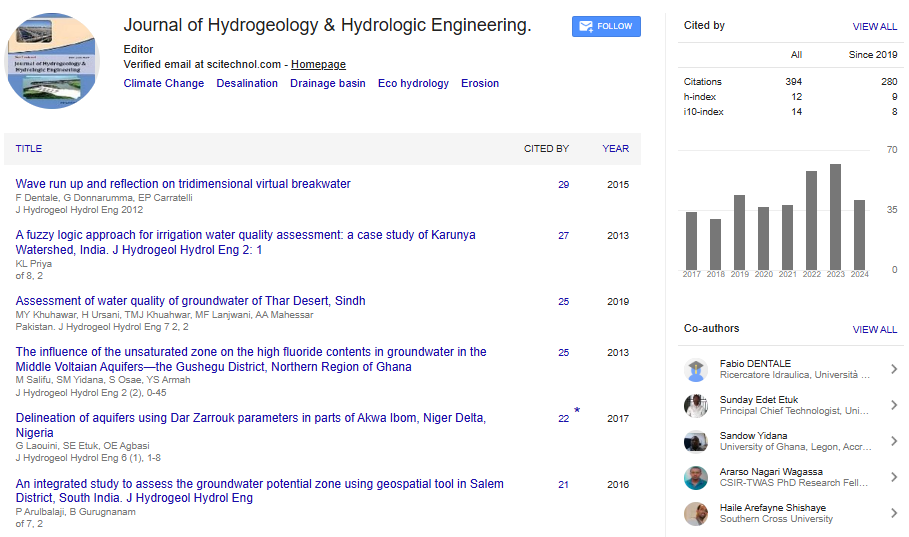Opinion Article, J Hydrogeol Hydrol Eng Vol: 13 Issue: 3
Sedimentation Control: Strategies, Benefits, and Implementation
Ibrahim Demir*
1Department of Environmental Engineering, Clemson University, Clemson, USA
*Corresponding Author: Ibrahim Demir,
Department of Environmental Engineering,
Clemson University, Clemson, USA
E-mail: demir27@gmail.com
Received date: 27 May, 2024, Manuscript No. JHHE-24-144609;
Editor assigned date: 30 May, 2024, PreQC No. JHHE-24-144609 (PQ);
Reviewed date: 13 June, 2024, QC No. JHHE-24-144609;
Revised date: 21 June, 2024, Manuscript No. JHHE-24-144609 (R);
Published date: 28 June, 2024, DOI: 10.4172/2325-9647.1000329
Citation: Demir I (2024) Sedimentation Control: Strategies, Benefits, and Implementation. J Hydrogeol Hydrol Eng 13:3.
Description
Sedimentation control is an essential aspect of environmental management aimed at preventing the deposition of soil, silt, and other debris in water bodies. Effective sedimentation control is essential for maintaining water quality, protecting aquatic habitats, and preventing the loss of valuable soil resources. This article delves into the importance of sedimentation control, the various methods used and the benefits of implementing these strategies. Sedimentation occurs when soil particles are transported by water or wind and subsequently deposited in rivers, lakes, reservoirs, or other bodies of water. This process can be accelerated by human activities such as construction, agriculture, and deforestation, leading to increased erosion and sediment load in waterways. Excessive sedimentation can degrade water quality, reduce the capacity of reservoirs, clog drainage systems, and harm aquatic ecosystems.
Importance of sedimentation control
Sediment-laden water can carry pollutants, including pesticides, heavy metals, and nutrients that contribute to water pollution. By controlling sedimentation, we can significantly reduce the amount of these pollutants entering water bodies, thereby improving water quality. Excessive sedimentation can smother aquatic habitats, such as fish spawning grounds and coral reefs, disrupting the life cycles of aquatic organisms. Sedimentation control helps preserve these habitats, supporting biodiversity and ecosystem health. Erosion and sedimentation result in the loss of topsoil, which is essential for plant growth. Implementing sedimentation control measures can help conserve soil, maintaining agricultural productivity and preventing land degradation. Sediment can accumulate in rivers and drainage systems, reducing their capacity to carry water and increasing the risk of flooding. Effective sedimentation control helps maintain the flow capacity of these systems, reducing the likelihood of flood events.
These include techniques such as planting vegetation, using mulch, and applying erosion control blankets to stabilize soil and prevent erosion at the source. Vegetation, in particular, helps bind the soil with its roots, reducing the amount of soil that can be eroded and transported by water or wind. Sediment traps, silt fences, and straw wattles are physical barriers designed to intercept and capture sediment before it reaches water bodies. These structures are often used in construction sites and agricultural fields to control sediment runoff. These are designed to slow down water flow, allowing sediment to settle out of the water column before it is discharged into natural water bodies. Sedimentation ponds and basins are commonly used in urban areas and construction sites to manage stormwater runoff.
Riparian buffers are vegetated areas along the banks of rivers and streams that act as a natural filter, trapping sediment and other pollutants before they enter the water. These buffers also provide habitat for wildlife and enhance the aesthetic value of the landscape. These agricultural practices involve shaping the land to create level terraces or contour lines that reduce water runoff and soil erosion. By slowing down water flow, these techniques promote the infiltration of water into the soil and reduce the transport of sediment.
Implementation of sedimentation control
Conducting a thorough assessment of the site to identify potential sources of sediment and areas vulnerable to erosion. This includes evaluating soil types, topography, vegetation cover, and land use practices. Developing a sedimentation control plan that incorporates appropriate control measures based on the site assessment. This plan should outline the location, design, and maintenance requirements of each control measure. Proper installation of sedimentation control measures is precarious to their effectiveness. This involves following best management practices and ensuring that structures are correctly positioned and constructed. Regular monitoring and maintenance of sedimentation control measures are essential to ensure their continued effectiveness. This includes inspecting structures for damage, removing accumulated sediment, and making necessary repairs or adjustments.
Conclusion
Sedimentation control is an integral part of environmental management that offers numerous benefits, from improving water quality to protecting aquatic habitats and conserving soil resources. By understanding the importance of sedimentation control and implementing effective measures, we can mitigate the adverse impacts of sedimentation and promote sustainable land and water use practices. Effective sedimentation control requires a combination of erosion control practices, physical barriers, and proper planning and maintenance to achieve long-term success.
 Spanish
Spanish  Chinese
Chinese  Russian
Russian  German
German  French
French  Japanese
Japanese  Portuguese
Portuguese  Hindi
Hindi 
